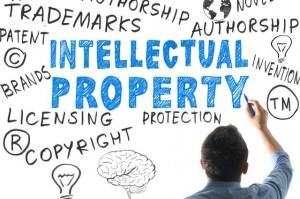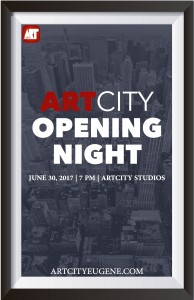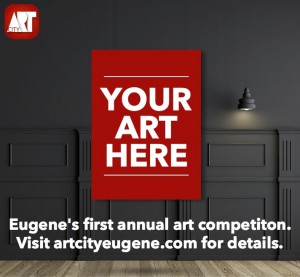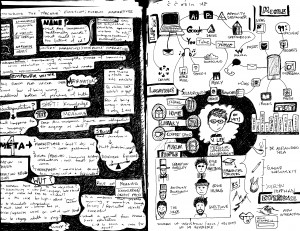- Develop a working understanding of the most commonly accepted marketing practices and a framework with which to evaluate them in different contexts.
- This was quite easily satisfied. I think I’ve gained a general understanding of various marketing strategies, at least at an introductory level and I feel comfortable evaluating their relative merits both in practice an in theory.
- Gain a better understanding of ethical concerns in communications and marketing, especially regarding problems/benefits of the sale of data and implications of anonymity breaches
- This isn’t something we touched on. It is perhaps outside of the realm of this class. We worked with pretty traditional strategies in terms of data. Seth’s presentation touched on various evaluative measures and consumer qualifiers but to a pretty small extent.
- Understanding the nature of desensitization toward advertising/marketing strategies in increasingly ad-saturated physical and digital spaces
- We didn’t really address this either although it is clear how certain strategies, like guerrilla marketing, can break through barriers of desensitization.
- Learning what techniques can be used to implicitly manipulate potential customers – psychology of marketing strategies
- This is something Seth discusses in his conversation around profiling consumers to advertise not only to their identities, but to who they want to project themselves to be.
- Understand the role of big-data in marketing and it’s potential for future applications
- This wasn’t really touched on. Seth discussed data in a small-scale realm. We didn’t quite touch on any implications or possibilities for large cultural institutions to use big data as corporations are.
- Learn creative ways to circumvent restrictive marketing budgets most effectively
- This came through in practice as we worked to develop marketing strategies for OSLP. We were very aware of their budget restrictions and had to manipulate our resources to the best of our abilities.
OSLP Marketing
Viral Marketing in the Culinary Arts
“Viral marketing campaigns catalyzed by food publicity stunts are prevalent throughout the culinary arts and the restaurant industry. The strategy is seen across the spectrum from the higher echelons of exclusive fine dining to the more accessible realm of fast food empires. Stunt marketing captures user interest through absurdity – be this in the context of bizarre foods or bizarre promotion surrounding the food. This paper considers its strengths and weaknesses through theory and specific case studies.”
[embeddoc url=”https://blogs.uoregon.edu/vlee/files/2017/02/lexicons-1n0ks78.pdf” download=”all” viewer=”google”]
[embeddoc url=”https://blogs.uoregon.edu/vlee/files/2017/02/Stunt-food-1n6hvib.pdf” download=”all” viewer=”google”]
Media Map
Learning Goals
- Develop a working understanding of the most commonly accepted marketing practices and a framework with which to evaluate them in different contexts.
- Gain a better understanding of ethical concerns in communications and marketing, especially regarding problems/benefits of the sale of data and implications of anonymity breaches
- Understanding the nature of desensitization toward advertising/marketing strategies in increasingly ad-saturated physical and digital spaces
- Learning what techniques can be used to implicitly manipulate potential customers – psychology of marketing strategies
- Understand the role of big-data in marketing and it’s potential for future applications
- Learn creative ways to circumvent restrictive marketing budgets most effectively
Learning Objectives Reflection
This post relates directly to my initial learning objectives for this class.
Through practice with the graphic standards, I think I’ve been able to foster a better understanding of how design elements affect the overall aesthetic and perception. I’ve been able to experiment and see from my peers’ work that small changes in factors like line weight lend significantly to the overall composition.
I don’t feel that I have a better understanding of how design affects human psychology in theory but it’s something I have become more aware of through this class.
I don’t think I’ve learned how marketing for arts organizations differs to that of other organizations, outside of the idea that they are trying to convey a different mission. This is true for all sectors.
I think I’ve developed a much stronger understanding of raster and vector graphics. I’ve gained a stronger familiarity with Illustrator and have become familiar with a new software, Affinity Designer. I feel much better equipped to work with vector graphics software in the future.
I wish I had engaged more in the theory of media and communications. I think my learning has leaned heavily on the technical side. I don’t recognize a growth in knowledge pertaining to ethical considerations in communications or the communicative nuances between various media types.
Lexicon 8
KERNING
Adjusting the distance between individual letters in a font, not to all of the letters as a whole. The ability to adjust small details like letter spacing allows for maximized control over distribution of space within a piece.
EMPHASIS
Emphasis is the use of create an aspect of visual prominence, perhaps similar to a focal point. By creating an area of emphasis, whether it is in terms of the design or as a means to highlight important information, the creator is able to attract user attention to the intended point.
DESCENDER
A descender is the part of a letter than extends below its baseline, such as the tail in “y.”
VISUAL IMPACT
Visual impact is a marker of immediate affect a piece has on the viewer. This is the emotional response, both initial and extending into the future. Impact can be positive or negative but cannot be neutral.
CONSTRAINTS
When working for a client, a number of constraints can affect the outcome. These include deadlines, client opinions, company standards/style guides, budget, and available software.
Lexicon 7

INTELLECTUAL PROPERTY
Intellectual property formally credits and protects the creator of outputs of the mind such as writings or conceptual inventions. A logo design would fall under this category. Ownership means others cannot steal the concept or use it for their own benefit. Proceeds and reference tie directly back to the originator. The concept is extremely important in economics as a means of behavioral incentivization. Protection encourages innovation and creation by guaranteeing benefit only to the owner.
MINIMALIST
Minimalism is the concept of eschewing what is not absolutely necessary. In the context of visual design, this means reducing the project to its most essential elements. A mainstream, contemporary example of minimalist aesthetics can be seen with Apple.
TRANSMEDIA
Transmedia refers to communications or narratives that occur across multiple media platforms. By engaging audiences on a number of intellectual modalities, participants are able to engage in the narrative to a greater extent. This is a useful tool in education as well. For example, telling a history narrative with a digital gaming component may be more memorable and interesting to students than the sole medium of a published boo. When people can interact with a project in multiple ways (reading the story, making choices in a game, seeing a graphic representation) they are more likely to retain.
BUCKLEY
Woof, woof. Good boy.
Poster/Display Ad



Personal Learning Environment

My personal learning environment is represented as sketches in a notebook. This medium is, in itself, a large part of my learning experience. In this instance I used a notebook that is primarily class notes because it represents my learning in the most traditional sense – the left side of the page is notes from the Museum Education class. I wanted to integrate the assignment with my real class notes so they would become a part of my learning environment. The sketch/doodle format alludes to my note-taking method. By representing ideas visually I engage with them differently: listening, understanding, applying, translating to an image, writing, and drawing encompass a greater number of learning modalities.
I started with myself in the center as the core of my PLE. I then identified what I perceive to be the primary categories that influence my learning: Digital (laptop, cellphone), physical locations, literature or texts, experiences, and influential people (past teachers, and some of my personal hero-figures).
The digital section encompasses main applications, software, and websites that I use to learn and while learning. Digital fabrication software like Affinity designer, Sketchbook, and Wacom occupy a significant portion of my time. Sound plays a large role as I use music as a background or Soundrown to block out noises around me. Apps like Canvas, inClass, Reminders, and Google Drive allow me to stay organized and work on assignments while apps like Apple News and the podcast 99% invisible allow me to engage with topics of interest including design solutions and journalism.
Locations are the physical places where I learn most frequently; home, university, cafes, libraries, and museums. However, I think most of my explicit learning occurs in a digital environment.
Texts represent the author’s, books, or publications that have contributed to my intellectual composition the most. These are texts that I feel have changed the ways in which I think. The existentialism and absurdism of Sartre and Camus completely altered my mental landscape. The journalism from Hunter S. Thompson, the New Yorker, and the NYT actualized an understanding of the power of the written word. I’m increasingly interested in the manipulative power of text-based media and am generally in reverence of the eloquent. Authors like Sebastian Horsley, Anthony Bourdain, and Jonathan Franzen have become objects of that reverence and have changed the ways I engage with and appreciate literature.
Experience is always a source of implicit learning. In meeting new people I am exposed to new ideas and backgrounds while developing a greater sense of interpreting body language and social cues. Putting myself in new circumstances forces me to learn more about who I am and how I react to various situations and stimuli. By trying to always say “yes” to something new and by changing my environment I am able to avoid stagnation.
People have lent to my learning environment perhaps more strongly than any other category. I divided this into two sections: teachers and inspiration-figures. I’ve never had a bad teacher but I think three have changed the direction of my life to a large enough extent that it’s worth mentioning. Dr. Sela was my 11th grade philosophy and Latin roots teacher. My high school teachers were a rather generic bunch. Grey pants, blue button-ups, fresh faces, class syllabi downloaded straight from a textbook’s website. He was this eccentric old man with tweed suits and a pipe who would mow the school lawn with an old-fashioned reel push mower on his breaks. He started every class with meditation and yoga and was passionate about wine and ping pong. He was the first person I had ever met who wanted to engage in the topics I was interested in. At the time, I was obsessed with the Beats-generation writers and he had known Allen Ginsberg personally. As an impressionable kid, this was the epitome of cool. Dr. Sela was the first person to introduce me to philosophy and the first teacher to genuinely challenge me. In some sense, he taught me how to think and led me to a slew of undergraduate and graduate philosophy courses that lent significantly to my identity. If I could redo life an infinite number of times, I would take his class in every iteration.
Jocelyn Hoffman taught French for my middle and high school. In the same generic backdrop, she was a ball of fire. Covered in tattoos and with hot-pink hair, she was a roller derby veteran with an unconventional wardrobe. she taught me about individuality. To put it bluntly, she taught me that you can be an intellectual and a professional without having to follow all of the rules and that left a huge impression on me.
Eugene Korsunskiy directs the Design Initiatives program at the University of Vermont. He became a mentor during my time there and taught me design thinking and art of innovation. He opened up a whole new world for me with design thinking strategies that have come to shape how I approach designing my life every day.
The last portion of people listed are public figures that I have come to admire for their writing, the causes they represent, and the relatability they have offered me. For example, Eddie Huang, chef, writer, lawyer, and restaurateur, relates the first-generation Asian-American experience. He translates race, identity, and culture through food and helped me to understand and take pride in who I am; something I was once ashamed of. Growing up, food was an overhanging metaphor for my mixed identity with a Chinese immigrant father and a white, American mother. My lunchbox was a pb&j sandwich next to dried squid. But I went to an essentially all-white school and where dried squid was weird and, by association, I was the “other.” We had a teacher, Mr. Lee, who was purely Italian. I have no idea how he came into that last name but I realized that Lee, which was this blazing emblem of difference for me, didn’t have to be. I thought I could pretend to not be asian, because he wasn’t. I would beg my dad to eat “white people food,” to not speak Mandarin in public. But as I’ve grown older, people like Huang, Bourdain, and Questlove have shown me the importance of food as identity and the pride that lies within that. By reading Huang’s narrative of the same struggle in his life, I’ve been able to reach the same point of acceptance and pride that he did.
